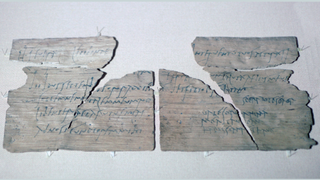
(Image credit: The Print Collector / Alamy Stock Photo)
Name: Birthday invitation to Sulpicia Lepidina
What it is: A wooden tablet with carbon-based ink
Where it is from: Vindolanda Roman fort, in Northumberland, U.K.
When it was made: A.D. 97 to 103
Related: Queen Puabi’s lyre: A bull-headed music maker played for Mesopotamian royalty 4,500 years ago
What it tells us about the past:
This wooden tablet is the earliest known example of Latin writing by a woman, Claudia Severa, who invited her good friend Sulpicia Lepidina to her birthday party. The invitation was found at the Roman fort of Vindolanda, where oxygen-free soil helped preserve numerous organic artifacts, including shoes and camping equipment, that normally would have disintegrated over time.
The postcard-sized tablet measures 8.8 by 3.8 inches (22.3 by 9.6 centimeters), and the text was made with carbon-based ink on both sides.
One side of the letter names both the writer and the addressee and reads, “To Sulpicia Lepidina, wife of Cerialis, from [Claudia] Severa,” according to the British Museum, where the object is housed.
The other side is the party invitation. The text, according to a translation from the British Museum, reads as follows: “Claudia Severa to her Lepidina, greetings. On September 11, sister, for the day of the celebration of my birthday, I give you a warm invitation to make sure that you come to us, to make the day more enjoyable for me by your arrival, if you are present. Give my greetings to your [husband, Flavius] Cerialis. My [husband] Aelius [Brocchus] and my little son send him their greetings.”
MORE ASTONISHING ARTIFACTS
All of this text was likely dictated to a scribe, who wrote it down in a slim, elegant script. But in a second handwriting style in the lower-right corner, Claudia Severa herself has written at the bottom of the invitation in a less elegant script, “I shall expect you, sister. Farewell, sister, my dearest soul, as I hope to prosper, and hail.” Although Severa was clearly literate and able to write the letter herself, her social status likely allowed her regular use of a scribe to pen missives on her behalf.
At least 1,700 writing tablets have been recovered from Vindolanda since the first one was found in 1973, and they provide an extraordinary glimpse into the daily lives of Roman military families along Hadrian’s Wall. But the letter from Claudia to Sulpicia is the best known, as it is both a poignant reminder of the importance of family and celebrations, as well as the earliest example of a Roman woman’s Latin handwriting.
































